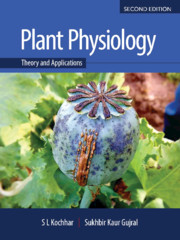Book contents
- Frontmatter
- Contents
- Foreword
- Preface to the Second Edition
- Preface to the First Edition
- Acknowledgements
- Some Common Abbreviations used in the Text
- Abbreviations for Units
- Unit I Water and Mineral Translocation in Plants
- Unit II Metabolism and Bioenergetics
- Unit III Growth and Development
- Unit IV Physiological Stress and Secondary Metabolites – Their Role in Metabolism
- Unit V Crop Physiology – An Innovative Approach
- Unit VI Breakthroughs in Plant Physiology
- Unit VII Some Experimental Exercises
- Glossary
- References
- Index
- Colour Plates
Chapter 14 - Dormancy, Germination and Flowering
Published online by Cambridge University Press: 12 May 2020
- Frontmatter
- Contents
- Foreword
- Preface to the Second Edition
- Preface to the First Edition
- Acknowledgements
- Some Common Abbreviations used in the Text
- Abbreviations for Units
- Unit I Water and Mineral Translocation in Plants
- Unit II Metabolism and Bioenergetics
- Unit III Growth and Development
- Unit IV Physiological Stress and Secondary Metabolites – Their Role in Metabolism
- Unit V Crop Physiology – An Innovative Approach
- Unit VI Breakthroughs in Plant Physiology
- Unit VII Some Experimental Exercises
- Glossary
- References
- Index
- Colour Plates
Summary
The growth and development of a flowering plant is a complex phenomenon. It begins with seed germination, accompanied by a series of large number of morphological and physiological changes termed as growth and development. The plant is in part a consequence of its genetic composition and in part a consequence of the environment in which it grows and develops. To some extent, the genome appears to be preprogrammed, but the program is highly modified by environmental factors.
The terms Growth, Differentiation and Development are customarily used to describe different aspects of the events that a plant undergoes during its life span. Development is an expression of the genetic program that governs the activities and interactions of individual cells. Development is the sum total of two processes: growth and differentiation. Growth is a quantitative term, related to an increase in size and mass, while differentiation is a series of qualitative changes in the cell, tissue or organ. Many parameters (increase in number of cells/fresh weight/dry weight/length and width/area and volume) could be invoked to measure growth depending upon the need of a researcher. Whatever the measure, growth is an irreversible increase in volume or size followed by the synthesis of new protoplasmic constituents.
Growth comprises of three phases: (i) cell division, (ii) cell enlargement, (iii) cell maturation.
The orderly development of a complex multicellular organism is coordinated by internal and external controls. ‘Internal controls’ are expressed at both the intracellular and intercellular levels. Intracellular controls are primarily genetic, requiring a programmed sequence of gene expression. Intercellular controls are primarily hormonal, chemical messengers that permit cells to communicate with each other. ‘External controls’ are environmental such as light, temperature and gravity. Many environmental variables seem to act at least in part by altering gene expression or hormonal functions.
Growth Curve
The sigmoid (S-shaped) growth curve is characteristic for virtually growth in all living organisms. It can be classified into three phases: Lag phase, Log phase, and Stationary phase (Figure 14.1).
- Type
- Chapter
- Information
- Plant PhysiologyTheory and Applications, pp. 411 - 452Publisher: Cambridge University PressPrint publication year: 2020



